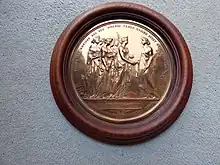| 1875 Melbourne | |
|---|---|
 Redmond Barry, chairman of the commissioners | |
| Overview | |
| BIE-class | Unrecognized exposition |
| Name | Victorian Intercolonial Exhibition |
| Visitors | 300000[1] |
| Participant(s) | |
| Countries | 7 |
| Location | |
| Country | Colony of Victoria |
| City | Melbourne |
| Coordinates | 37°48′35″S 144°57′53″E / 37.809801°S 144.964787°E |
| Timeline | |
| Opening | 2 September 1875 |
| Closure | 16 November 1875 |
The Victorian Intercolonial Exhibition world's fair[2] was held in Melbourne, Colony of Victoria between 2 September and 16 November 1875.[3]
Commission
The original commission comprised Sir Redmond Barry, acting chief justice; members of the Victorian Legislative Assembly (M.L.A.): J. J. Casey, J. F. Sullivan, C. J. Jennor, J. Munro; James Gatehouse (mayor of Melbourne); the former mayor J. McIlwraith; and J. I. Bleasdale.[4]
And later the following became additional commissioners: John O'Shanassy (former premier of Victoria); James McCulloch, J. A. Macpherson, J. T. Smith, J. Bosisto (all M.L.A.s); S. H. Bindon; the Count de Castelnau; L. J. Sherrard; and J. Danks.[4] G. C. Levey who had experience with the Victorian Exhibition of 1872, and the London International and Vienna Exhibitions of 1873 was appointed secretary.[4]
Location
The exhibition was held in the Public Library (as were earlier exhibitions in 1866 and 1872) along with a specially constructed 190 ft by 60 ft iron and wood building.[4]
Contributors
There were exhibitors from the colonies of Victoria (805), New South Wales, South Australia, Tasmania (118) and Northern Territory (86), along with Singapore (2) and Japan (2).[1]
Displays
Displays included two beer exhibits from Yarra Bend Asylum,[5] three copper engraved maps of Victoria organised by Alexander John Skene and A C Allen and engraved by Slight[6] and The Lord's Prayer in 50 different kinds of shorthand[7]
The Victorian Academy of Arts organised the Fine Arts section which included paintings by Louis Buvelot, Eugene von Guerard, Isaac Whitehead and Henry Leonardus van den Houten.[8]
Awards
The awards given during the exhibition included the Intercolonial Exhibition medal. 648 medals were produced to be awarded to winning exhibitors in various categories.[9] The medal included a latin inscription and was designed by prominent sculptor of the period, Charles Summers.

Closing
At the closing ceremony at noon on 16 November, Redmond Barry, chairman of the commissioners, addressing the acting governor William Stawell summarised the numbers of exhibitors, visitors and proceeds. He described jury selection and summarised medals awarded. He also thanked the jurors and the trustees of the Public Library and National Museum for the use of their great hall and annexes.[1]
References
- 1 2 3 "THE INTERCOLONIAL EXHIBITION". The Argus (Melbourne, Vic. : 1848 - 1957). 17 November 1875. p. 9.
- ↑ Pelle, Findling, ed. (2008). "Appendix D:Fairs Not Included". Encyclopedia of World's Fairs and Expositions. McFarland & Company, Inc. p. 424. ISBN 978-0-7864-3416-9.
- ↑ "1875-76 - Intercolonial and international exhibitions - Research Guides at State Library of Victoria". Retrieved 26 July 2017.
- 1 2 3 4 "Account of the Victorian Exhibition of 1875 an 8 page supplement in The Argus". 3 September 1875.
- ↑ "Victorian Intercolonial Exhibition (1875 : Melbourne, Vic.) Official catalogue of exhibits". p. 93.
- ↑ "Victorian Intercolonial Exhibition (1875 : Melbourne, Vic.) Official catalogue of exhibits". p. 185.
- ↑ "Victorian Intercolonial Exhibition (1875 : Melbourne, Vic.) Official catalogue of exhibits". p. 206.
- ↑ "Victorian Intercolonial Exhibition (1875 : Melbourne, Vic.) Official catalogue of exhibits". p. 207.
- ↑ "Medal - Intercolonial Exhibition of Australasia, Melbourne, Australia, 1866-1867".